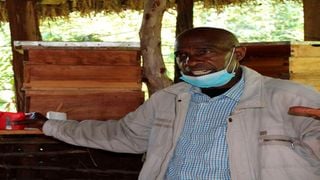
Muruga Gatero, a retired teacher on his bee farm.
Seeds of Gold
Premium
A ‘sting of success’ with bees for retired teacher
A murram road from Shauri market in Nyandarua County leads one to a farm hosting well-maintained indigenous trees, shrubs, and natural vegetation.
A 20-metre path from the main gate stretches into the compound where owner Muruga Gatero keeps 20 Kienyeji chickens, 10 rabbits, three sheep, four goats and 5,000 fish in three ponds.
Not far from the livestock farm is Gatero’s apiary, a round hut with a diameter of 12 feet, well-thatched and surrounded by indigenous trees and fruit trees.
Despite the many ventures that Gatero engages in on his five-acre farm, he says his heart is in the bee venture.
“Bees are friendly to humans unless you provoke them. They are never idle, always busy looking for nectar. They have no time to go attacking people, aggression is not their nature,” he says, explaining why his home is less than 50 metres from the apiary. The indigenous trees he has planted guide the bees on where to go, he says, adding they move in one direction up from the beehives, the reason why they coexist with the sheep and goats not far away from the apiary.
Besides selling honey in the local market, the former headteacher of Kwa Njira Primary School also trains farmers on beekeeping and environment conservation to create a conducive environment for apiculture.
Construction materials
He invested Sh50,000 to construct the hut, with the cost covering construction materials and labour.
“I bought timber posts, and sticks that are tied with a rope around the posts to hold the mud walls, which run about a metre from the ground.”
After constructing the hut, he bought the 30 beehives in 2018, investing Sh185,000.
He has two types of beehives, the Kenya Top Bar Hive and Langstroth hive, but his favourite is the former, which has two chambers, one hosting the queen bee making it easier to harvest the honey.
“At harvesting, one should not pick the honey in the queen's chamber, otherwise you risk attack by the bees protecting the queen, or they might decide to leave the beehive and migrate,” says the farmer.
The most critical part in beekeeping is attracting the bees in a hive, he adds.
“One must clean the hives, then smoke them with a sweet scent from bee attracting vegetation.”
At the apiary, it's important to keep some fresh water for the bees in small shallow containers.
Gatero harvests the honey twice a year, in March and October, getting a minimum of 10 kilos per hive per harvest and sells each at Sh1,000.
“Honey is never enough, we always have a shortage, people will always come for it if the quality is good,” says Gatero.
According to him, timing is critical to ensure maximum harvest and safety and comfort of the bees.
“Bees are very intelligent and are also likely to migrate from a hive if honey-eating insects visit. This can be prevented by oiling the posts and any other areas that insects can use to access the beehives.”
Honey-eating insects
He harvests when trees and other vegetation on the farm shed their flowers. “The easiest way to know when there is enough honey is by monitoring the bees’ activities, they are active in the hive when it has honey. They will move in and out of the hive but not travel far and they can easily attack.”
Irene Wambugu, the Ndaragua sub-county director of livestock development, says bee pasture, housing, environment, and routine management are critical issues a farmer must consider for maximum production and returns.
She recommends planting of acacia, eucalyptus and avocado trees to provide nectar for the bees.
“Tree lucerne is also good as a duo-purpose plant for animal fodder and pasture for the bees,” says Wambugu.
She says routine management that includes inspection of the apiary twice a month should be done to ensure that the hives are not attacked by honey-eating insects or animals.
“The best time to harvest is between 6pm and 7pm when the bees are resting but not when asleep to avoid interfering with their routine.”





